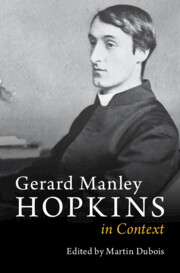Book contents
- Gerard Manley Hopkins in Context
- Gerard Manley Hopkins in Context
- Copyright page
- Contents
- Illustrations
- Notes on Contributors
- Note on Editions and Abbreviations
- Chronology
- Introduction
- Part I Places
- Part II Aesthetic and Cultural Contexts
- Part III Religious, Theological, and Philosophical Contexts
- Part IV Nature, Science, and the Environment
- Part V Gender, Sexuality, and the Body
- Part VI Form, Genre, and Poetics
- Chapter 25 Rhythm
- Chapter 26 Language
- Chapter 27 Address
- Chapter 28 Syntax
- Chapter 29 Rhyme
- Chapter 30 Ode
- Chapter 31 Sonnet
- Chapter 32 Letters
- Chapter 33 Journal Prose
- Chapter 34 Sermons
- Part VII Reception and Influence
- Further Reading
- Index
Chapter 29 - Rhyme
from Part VI - Form, Genre, and Poetics
Published online by Cambridge University Press: 16 January 2025
- Gerard Manley Hopkins in Context
- Gerard Manley Hopkins in Context
- Copyright page
- Contents
- Illustrations
- Notes on Contributors
- Note on Editions and Abbreviations
- Chronology
- Introduction
- Part I Places
- Part II Aesthetic and Cultural Contexts
- Part III Religious, Theological, and Philosophical Contexts
- Part IV Nature, Science, and the Environment
- Part V Gender, Sexuality, and the Body
- Part VI Form, Genre, and Poetics
- Chapter 25 Rhythm
- Chapter 26 Language
- Chapter 27 Address
- Chapter 28 Syntax
- Chapter 29 Rhyme
- Chapter 30 Ode
- Chapter 31 Sonnet
- Chapter 32 Letters
- Chapter 33 Journal Prose
- Chapter 34 Sermons
- Part VII Reception and Influence
- Further Reading
- Index
Summary
This chapter explores Hopkins and rhyme: both his views on the subject and his practice as a poet. It considers Hopkins as an artist caught between two conceptions of rhyme that stood in tension with one another. In the first view, rhyme is a metaphor for thinking about questions of cosmic design and coherence, and hence carries philosophical weight, and a religious and ethical charge. In the second, rhyme is aligned with pleasure and beauty, and needs to be disciplined and harnessed if it is not to be decadent or self-indulgent. The chapter considers Hopkins’s observations and pronouncements on the subject of rhyme in his letters and lectures and compares and contrasts them with the evidence of his poems, in which he often breaks his own rules. The chapter argues that Hopkins needed to be in more than one mind about rhyme in order to write the way he did.
Keywords
- Type
- Chapter
- Information
- Gerard Manley Hopkins in Context , pp. 253 - 260Publisher: Cambridge University PressPrint publication year: 2025

